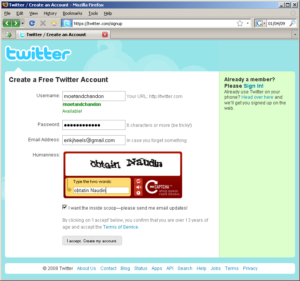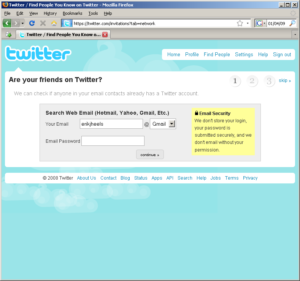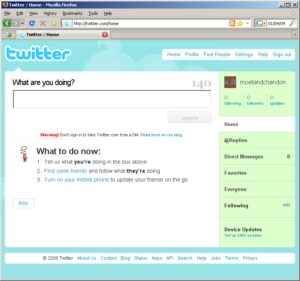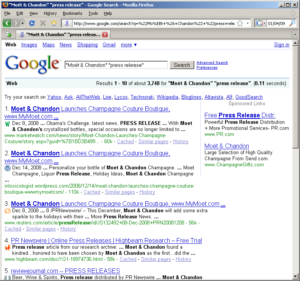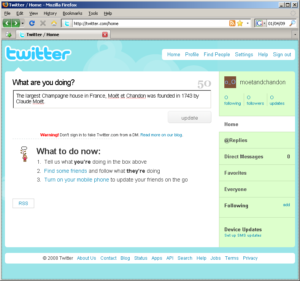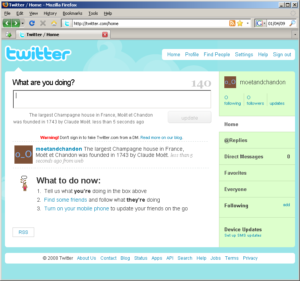A call for the creation of the Uniform Username Dispute Resolution Policy.
![]()
The Problem
Of the top 100 global brands, 93% have had their Twitter usernames taken by somebody else (i.e. Twittersquatted).
Twittersquatting, like cybersquatting, is when somebody registers a company’s trademark (or a famous person’s name) as a Twitter username with the intent of profiting or causing confusion. Other possible names for this practice include username squatting, usernamesquatting, squitting, usersquatting, and brandsquatting.
But username squatting is not limited to Twitter. It exists on any service that uses name-based accounts. Check your brand on Usernamecheck.com to see just how widespread the problem is. I am picking on Twitter because it is rapidly growing in popularity and because Twitter’s dispute resolution policy is particularly poor:
5. You may not use the Twitter.com service for any illegal or unauthorized purpose. International users agree to comply with all local laws regarding online conduct and acceptable content.
…
10. You must not, in the use of Twitter, violate any laws in your jurisdiction (including but not limited to copyright laws).
…
1. We reserve the right to modify or terminate the Twitter.com service for any reason, without notice at any time.
…
6. We reserve the right to reclaim usernames on behalf of businesses or individuals that hold legal claim or trademark on those usernames.
This policy raises more questions than it answers, creates more problems than it solves. Twitter “reserves the right” to “reclaim” squatted usernames? Does the account owner have any rights? Does the trademark owners? How are the disputes initiated?
Today, trying to reclaim a squatted username on Twitter is a hit-or-miss proposition.
This is a huge problem for trademark owners and social media companies alike. For trademark owners, their names are being taken by others, causing confusion in the marketplace and harming the trademark owner’s brand. For social media companies like Twitter, disputes about usernames are likely consuming valuable company resources.
And let’s not forget innocent users. There should be no presumption of guilt in any username policy.
A standard policy exists for resolving trademark disputes (e.g. cybersquatting) for most registered domain names, namely the Uniform Domain Name Dispute Resolution Policy (UDRP). I am hereby calling on the top social networking companies (Google, Twitter, MySpace, WordPress.com, and Microsoft) to create a UURP – Uniform Username Dispute Resolution Policy. Disputes will occur with our without good policies. Making a standardized policy will make dispute resolution less expensive.
A Username Dispute Resolution Policy is at least as important as OpenID, and many of the above are already cooperating on that initiative.
Domain Names ARE Usernames On Twitter
Confusion is not just likely with Twittersquatting, it is certain. Because on many Twitter clients, domain names are the functional equivalent of Twitter usernames.
Let’s use my username as an example. Many Twitter clients (such as TweetDeck) automatically convert any string containing “@example” into a link to Example’s Twitter account. So @example becomes http://twitter.com/example. This means that anytime anyone Tweets about an email address, a link is created to the corresponding Twitter account. So erikjheels@erikjheels.com becomes erikjheels@erikjheels.com, where @erikjheels becomes a link to http://twitter.com/ErikJHeels.
In other words, in many Twitter clients, the owner of the top-level domain name is assumed to be the owners of the corresponding Twitter account.
Top 100 Brands On Twitter – Fail and Epic Fail
With the top 100 brands, unfortunately, this is simply not the case. Most of the top brands on Twitter have been registered by squatters. Here is a breakdown of the top 100 global brands (as ranked by Interbrand):
brand | website | website grade (97% pass) | Twitter grade (93% fail) | |
Accenture | pass | pass | ||
adidas | pass | FAIL | ||
AIG | pass | FAIL | ||
Allianz | pass | FAIL | ||
amazon.com | pass | FAIL | ||
American Express | pass | FAIL | ||
Apple | pass | FAIL | ||
Armani | pass | FAIL | ||
Audi | pass | FAIL | ||
Avon | pass | FAIL | ||
AXA | pass | FAIL | ||
BlackBerry | pass | pass | ||
BMW | pass | FAIL | ||
BP | pass | FAIL | ||
Budweiser | pass | FAIL | ||
Canon | pass | FAIL | ||
Cartier | pass | FAIL | ||
Caterpillar | pass | FAIL | ||
Chanel | pass | FAIL | ||
Cisco | pass | FAIL | ||
Citi | pass | FAIL | ||
Coca-Cola | pass | FAIL | ||
Colgate | pass | FAIL | ||
Danone | pass | FAIL | ||
Dell | pass | FAIL | ||
Disney | pass | FAIL | ||
Duracell | pass | FAIL | ||
eBay | pass | FAIL | ||
FedEx | pass | FAIL | ||
Ferrari | pass | FAIL | ||
Ford | pass | FAIL | ||
Gap | pass | FAIL | ||
GE | pass | FAIL | ||
Gillette | pass | FAIL | ||
Goldman Sachs | pass | FAIL | ||
pass | FAIL | |||
Gucci | pass | FAIL | ||
H & M | EPIC FAIL | FAIL | ||
Harley-Davidson | pass | pass | ||
Heinz | pass | FAIL | ||
Hennessy | pass | FAIL | ||
Hermes | pass | FAIL | ||
Hewlett-Packard | pass | FAIL | ||
Honda | pass | FAIL | ||
HSBC | pass | FAIL | ||
Hyundai | pass | FAIL | ||
IBM | pass | FAIL | ||
Ikea | pass | FAIL | ||
ING | pass | FAIL | ||
Intel | pass | FAIL | ||
J.P. Morgan | pass | FAIL | ||
Johnson & Johnson | pass | EPIC FAIL | ||
Kellogg’s | pass | FAIL | ||
KFC | pass | FAIL | ||
Kleenex | pass | FAIL | ||
L’Oreal | pass | FAIL | ||
Lexus | pass | FAIL | ||
Louis Vuitton | pass | FAIL | ||
Marlboro | pass | FAIL | ||
Marriott | pass | FAIL | ||
McDonald’s | pass | FAIL | ||
Mercedes | pass | FAIL | ||
Merrill Lynch | pass | FAIL | ||
Microsoft | pass | FAIL | ||
Moet & Chandon | EPIC FAIL | EPIC FAIL | ||
Morgan Stanley | pass | FAIL | ||
Motorola | pass | FAIL | ||
MTV | pass | FAIL | ||
Nescafe | pass | FAIL | ||
Nestle | pass | FAIL | ||
Nike | pass | FAIL | ||
Nintendo | pass | FAIL | ||
Nivea | pass | FAIL | ||
Nokia | pass | FAIL | ||
Oracle | pass | pass | ||
Panasonic | pass | FAIL | ||
Pepsi | pass | FAIL | ||
Philips | pass | FAIL | ||
Pizza Hut | pass | FAIL | ||
Porsche | pass | FAIL | ||
Prada | pass | FAIL | ||
Rolex | pass | FAIL | ||
Samsung | pass | FAIL | ||
SAP | pass | EPIC FAIL | ||
Shell | pass | FAIL | ||
Siemens | pass | FAIL | ||
Smirnoff | pass | FAIL | ||
Sony | pass | FAIL | ||
Starbucks | pass | pass | ||
Thomson Reuters | pass | pass | ||
Tiffany & Co. | pass | FAIL | ||
Toyota | pass | FAIL | ||
UBS | pass | EPIC FAIL | ||
UPS | pass | FAIL | ||
Visa | pass | FAIL | ||
Volkswagen | pass | FAIL | ||
Wrigley’s | EPIC FAIL | FAIL | ||
Xerox | pass | FAIL | ||
Yahoo! | pass | pass | ||
Zara | pass | FAIL |
I’ve never heard of some of these companies. Perhaps next year’s chart should consider how clued each company is about its Internet presence before declaring them “top brands.”
To create domain names from brands, I removed all punctuation, changed “&” symbols to “and,” and eliminated all spaces. In other words, I crated the most obvious domain name for each brand.
Companies need to think more about how their brands work in the Internet age. FedEx got lucky. They started out as Federal Express before the Internet was all the rage then rebranded to FedEx. Today, they are FedEx. Nobody refers to them as Federal Express. American Express should follow this model and rebrand as AMEX. Since that’s what everybody calls them. (And “that’s what you call us anyway” was part of FedEx’s rebranding media campaign.) Other brands on this list need work, primarily because they are too long. Twitter usernames are limited to 15 characters, for example.
Grading:
- Any company that doesn’t own it’s dot-com domain name in 2009 gets a grade of EPIC FAIL. Use the UDRP or buy it. But own your brand at least as a dot-com domain name.
- Any company whose brand is longer than 15 characters (maximum Twitter username length) gets a grade of EPIC FAIL. Get a shorter brand.
- Any company that doesn’t have a Twitter username and whose username was unregistered at the time of this survey gets a grade of EPIC FAIL. It’s one thing to let your username go to a squatter, it’s another to not even try. (Twitter may be “reserving” some of the unregistered three-letter usernames.)
- Any company that doesn’t have the Twitter username that corresponds to its most obvious domain name gets a grade of FAIL.
Of the top 100 brands, only seven get a passing grade: Accenture, BlackBerry, Harley-Davidson, Oracle, Starbucks, Thomson Reuters, and Yahoo! And of these, only Starbucks and Oracle appear to be engaging in meaningful conversations on Twitter.
How To Spot A Twittersquatter
Sometimes it’s easy to spot a squatter, like when they brag about it as the squatter of the Goldman Sachs trademark has done:
squitter – someone (like me) who registers a brand name twitter handle for safekeeping and future profit
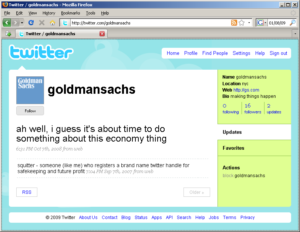
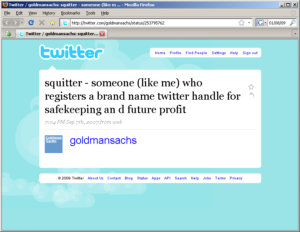
But sometimes Twittersquatting is harder to spot. Like when I do it to make a point.
For this article, I registered MoetAndChandon as an account on Twitter to (1) demonstrate how easy it is to create fake Twitter accounts that look real, (2) call attention to the problem of username squatting in general and Twittersquatting in particular, and (3) demonstrate the need for a Uniform Username Dispute Resolution Policy on all username-based social networks.
I will, of course, turn this account over to Twitter or Moet & Chandon as soon as possible after publishing this article.
How To Be A Twittersquatter
Step 1 – Create a fake account, preferably with a matching email account that you can create with any web-based email provider. (Note that I used my actual email address, thus doing an exceedingly poor job of hiding my true identity. It’s as if I’m trying to make a point or something. Just like Wired Magazine’s Joshua Quittner did in 1994 by registering mcdonalds.com.)
Step 2 – Invite your friends! You can skip this step. Nobody wants to be friends with a squatter.
Step 3 – Start Tweeting! But be careful. Your first Tweet is important. Make it a good one.
Step 4 – If your victim’s website sucks, try looking to their press releases for fodder for your – I mean their – first Tweet.
Step 5 – Tweet it!
Step 6 – Make it look legit! Add good bio info, a link to the victim’s website, perhaps some a copyrighted background image and trademarked avatar. You’ll note that I skipped this step, but here’s what your first Tweet looks like:
Congratulations, you are now a Twittersquatter.
Summary
I anticipate being misquoted and misunderstood, so for those with attention spans of 140 characters or less, here is a summary of my main points:
- Domain names became popular. Cybersquatting started. Then the UDRP helped resolve domain name disputes.
- Usernames have become popular. Username squatting (including, but not limited to, Twittersqatting) has started. A Uniform Username Dispute Resolution Policy (UURP) is needed to resolve username disputes.
- Branding on the Internet is no longer limited to dot-com websites. Usernames are also valuable.
- Twitter, in particular, needs to address this issue immediately. Twittersquatting is easy to do, widespread, and costly to remedy.
- 97% of the top 100 brands score a passing grade for protecting their brands as domain names.
- 93% of the top 100 brands score a failing grade for protecting their usernames on Twitter.
This is a solvable problem. Let’s solve it.
Related Posts
- FreeTrademarksForStartups.com: Free Trademarks For Startups
The best time for entrepreneurs to start a new business is during a recession. - Madrid Protocol: Affordable International Trademarks For Startups
The Madrid Protocol is a great option for startups who want foreign trademark protection but don’t want to file trademarks in separate countries. - Domain Name Law
White hat domainers are not black hat cybersquatters. - Drawing That Explains Copyright Law
Copyright rights, unregulated uses, and fair use.


